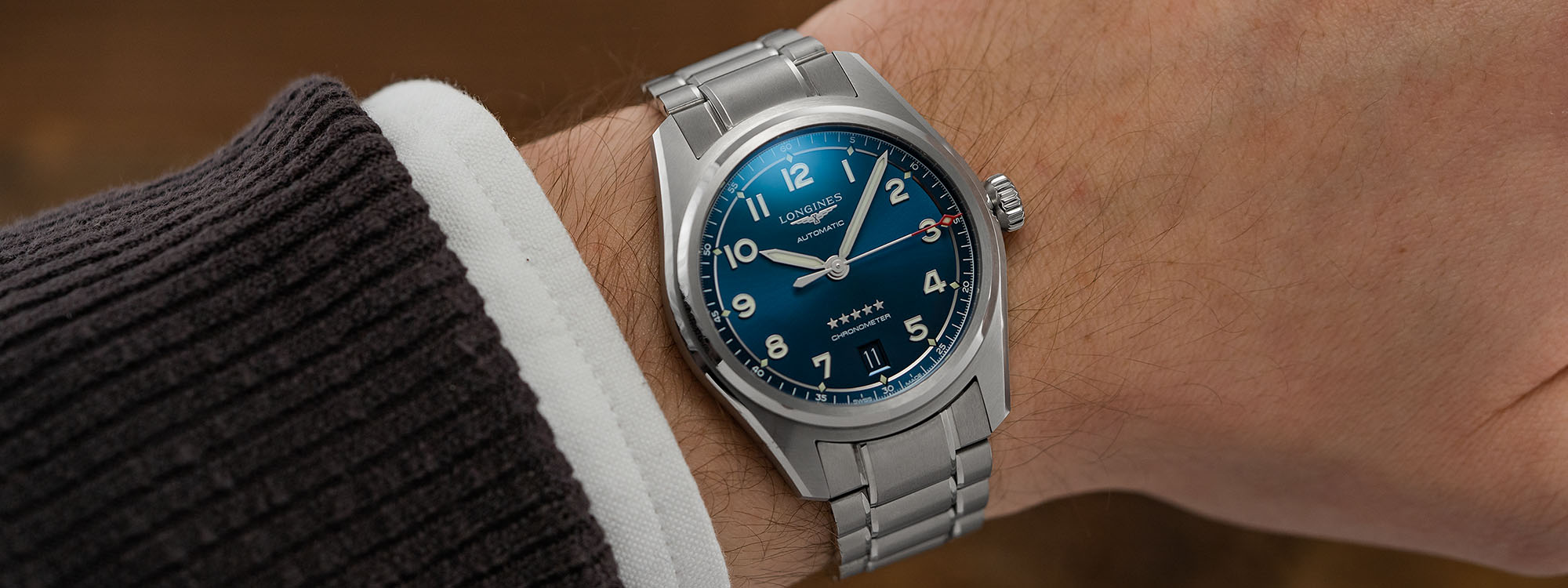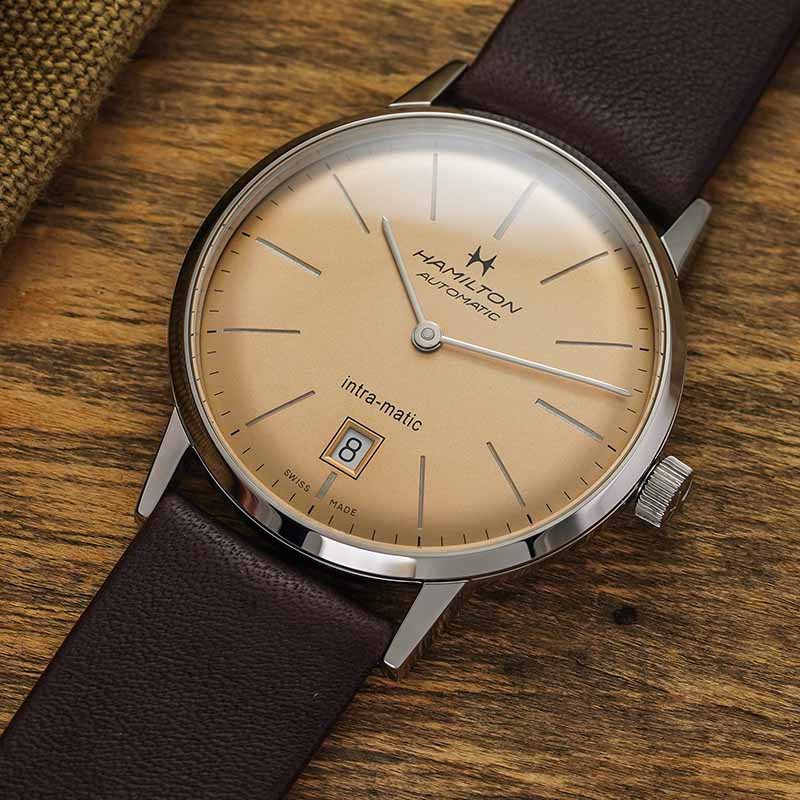One of the most important factors one considers when choosing a new watch is the watch's size — as in, its appropriateness relative to the size of one's own wrist as well as the general statement that it's making on said wrist. Trying watches on before buying them is, of course, the easiest and most sensible way to determine these factors, but when you're buying watches online, like so many of us are these days, the eyeballing and hands-on experience must give way to some carefully conducted research instead. Here we pose and answer (to the best of our knowledge and experience) some of the questions a prospective online watch purchaser is likely to have regarding watch sizes and wrist sizes.
What watch size is right for my wrist?

While there are obviously some practical calculations that you can make, it all comes down to comfort and personal style. Some people with very slender wrists like to rock a big, attention-grabbing timepiece, and occasionally a linebacker type with thicker forearms might prefer to keep it more subtle with a smaller watch that hides under a sleeve. Acknowledging that these tend to be the outliers, however, most watch wearers will want some aesthetic harmony between their watch size and wrist size, which means that you’ll want to get an accurate idea of both actual measurements. This is particularly important if you’re buying a watch online without actually physically trying it on.
You can measure your wrist size easily by wrapping a tape measure around its circumference. Measuring the watch case’s diameter (providing you don’t already know it from the manufacturer or the retailer) requires a device called a caliper, preferably one with metric system measurements; watch sizes tend to be measured in millimeters. Simply loosen the caliper’s “jaws” and then screw them tightly around the sides of the case at about 8 and 2 o’clock (avoid the crown) to get your base measurement. From these two results, you can begin to start matching up watch options with your wrist size. Here are some suggested guidelines based on our own experiences: a six-inch wrist is generally considered “smaller,” so a case size in the range of 34mm to 38mm would be appropriate; an “average”-sized wrist, generally around 7 to 7 ½ inches, can accommodate a larger watch, from around 39mm to about 42mm or even 43mm. On wrists measuring 8 inches or larger, you might opt for what are often termed “oversized” case diameters of 44mm, 46mm, or even larger.
What’s the right size for a dive watch, dress watch, et cetera?
Of course, different types of watches have different functions, capabilities and even standards of legibility. All of these factors affect the size of the watch. A chronograph that is too small won’t be very readable, and a classically elegant dress watch loses much of its understated charm if it’s too dominant on the wrist. Again, the following size ranges are not definitive but are useful guidelines nonetheless:

Dress watches, i.e., watches that are generally worn in formal situations and are not overly complicated in their design and functionality, tend to fall in the range of 36mm to 41mm in diameter (and 42mm to 47mm lug width, a measurement we’ll get into in a bit), with 39mm as a good sweet spot for an average wrist. Many higher-end dress watches have cases made of precious metals like gold, which is not only heavy but also somewhat ostentatious at larger sizes, making smaller and thinner case dimensions desirable. The A. Lange & Söhne Lange 1 (above), one of the quintessential luxury dress watches on the market today, measures an understated (and perfect) 38.5mm in diameter and 8.9mm thick, the same dimensions as when it debuted in 1994.

Dive watches, as their name implies, are built to be worn underwater, often at great depths, and thus need to be exceptionally water resistant as well as readable deep under water where light doesn’t penetrate. Sizes on some of the most popular dive watches range from 39mm to 42mm (the Rolex Submariner is 40.5mm and the Omega Seamaster 300 Diver, above, is 42mm), but many are even larger, like the Panerai Submersible at a stately 47mm. Larger sizes are a hallmark of dive watches, because both the bezel, with its dive-scale insert, and the dial, which is usually also highly luminous, need to be easily readable in diving conditions. Depending on the level of water resistance, dive watch cases are also substantially thicker than those of non-dive watches: Citizen’s Promaster Diver 1000M is a robust 21mm thick in addition to being a wrist-dominating 52mm in diameter.

Field watches, first worn by soldiers in the early 20th Century, are generally characterized by toughness in construction, simplicity in dial design, and modesty in case dimensions: the smaller and lighter the watch, the less burden it put on a soldier who was already carrying a load of gear. Nowadays, field watches are mostly larger than their wartime predecessors but still understated compared to dive watches or pilots’ watches: 37mm to 40mm, with a few going larger and a handful of retro models sticking to the classical smaller dimensions, i.e., the 36mm of the classic Rolex Explorer. Both the Bulova Hack Watch (above) and Hamilton Khaki Field Mechanical are 38mm, so that might be considered the sweet spot.

Pilots’ watches, like dive watches, tend to be on the larger side for reasons that are similar yet slightly different: the classic “Flieger” look that defines many in the genre is all about legibility (in a dark cockpit rather than deep underwater), and their cases may need to be thicker than usual to accommodate a soft iron inner case to protect the movement from magnetic fields. Two of the most iconic pilots' watches are very different types of timepieces, but both are robustly sized at 46mm: IWC’s Big Pilot’s Watch and Breitling’s original Navitimer. Pilot’s watches, which are more diverse in their functionalities and aesthetics than dive watches, offer a wide range of sizes, from around 38mm all the way up to 55mm for some of the vintage-look Fliegers. Many of the popular large models, however, are now available in smaller versions, like the IWC Big Pilot 43 (above), Breitling Navitimer 41, and Longines Spirit 37mm (our featured image at top).
Why do some watches wear larger or smaller than their actual size?

Sometimes you’ll put a watch on, knowing the stated case size, and be surprised by how much smaller (or in some cases larger) it looks on the wrist than expected. One reason for this is likely the dial-to-bezel ratio. In other words, a larger bezel (such as the unidirectional rotating bezel on a dive watch), can have the optical illusory effect of making the dial it frames look smaller. Conversely, a thinner bezel, like the ones on minimalist dress watches like the Junghans Max Bill (above) or Nomos Tangente, which have been described as "practically bezel-less," can have the opposite effect of making the dial appear wider and more expansive.
Why is the lug-to-lug measurement important?

The lugs, sometimes called “horns,” are the protruding parts of the case that connect it to the bracelet or strap. The distance from the tip of the top lugs to the tip of the bottom lugs is another factor that affects not only how large the watch “wears” on the wrist but also how comfortable it is. When the lug-to-lug measurement is close to the case diameter, the watch tends to “wear” smaller, i.e. the Seiko “Turtle” dive watch, whose case diameter is a rather hefty 45mm but whose lugs are very short and tight to the case, 47.7mm from lug to lug. By contrast, the Hamilton Khaki Field Mechanical case is only 38mm in diameter but its lugs widen out to 47mm, making it appear somewhat larger. Lug to lug measurement is particularly important on watches that are not round, like the Cartier Tank and Jaeger-LeCoultre Reverso (above). The latter watch’s 27.4mm width makes it sound deceptively dainty, but its lug-to-lug span of 45.2mm gives you a better idea of how much real estate the watch will take up on the wrist.
How important are factors like thickness and weight?

The thickness of a watch case imparts less to its wrist presence than its diameter or lug width but it’s still a factor to consider for practical purposes. If you’ll be wearing the watch under the sleeve of a dress shirt, for example, you don’t want it to be so thick that it bulges out from under the cuff. Dive watches, as mentioned above, tend to be thicker in service of being more water resistant. Chronographs, and other watches with added complications like world timers or calendars, also tend to be thicker than simple three-handed models because the movements inside them are thicker to accommodate the added functions. (This is why it’s such a big deal, for example, when watchmakers like Piaget and Bulgari create high-complication watches with impossibly thin movements and cases; you can read about some of those here.) Some ballpark recommendations on thickness: under 10mm is generally regarded as thin, under 15mm is about average, and over 15mm would be considered thick. The facets and curves of a watch case can also play a role in its wearability: the Tudor Black Bay (above), with its bulging convex caseback, wears higher on the wrist than a similar dive watch like the Rado Captain Cook, which has a slimmer caseback. Also remember that the height of the crystal over the case is generally not included in the official measurement of the case thickness; a domed crystal, which is an increasingly popular feature on dive watches particularly, can enhance legibility but also add some girth to the watch overall.
 Weight is probably the least impactful measure from an aesthetic standpoint when choosing a watch but still has a bearing on comfort. It’s also worth pointing out that watchmakers’ use of materials like titanium and ceramic, which are solid and sturdy but much lighter than traditional stainless steel, allows them to make watches that are bigger but also more comfortable to wear on a variety of wrists. The TAG Heuer Aquaracer shown above measures a rather large 43mm in diameter and resists water pressure to 300 meters, but weighs just 122 grams thanks to both its case and bracelet being made from sandblasted titanium. A watch on a metal bracelet, of course, will be heavier on the wrist than a watch on a leather strap, which will be marginally heavier than a watch on a fabric NATO strap. Precious metals are heavier than steel or titanium, in addition to being more expensive. (Theoretically, the heaviest and most expensive watch one could buy would have a full-platinum case and full-platinum bracelet and a highly complicated movement inside.) By way of example, here are the weights of several metals used in watchmaking by cubic centimeter: titanium: 4.54 grams; 316L stainless steel, 8 grams; bronze, approximately 8.94 grams depending on specific alloy; tantalum, 16.65 grams; 18k gold, 19.32 grams; platinum, 21.45 grams.
Weight is probably the least impactful measure from an aesthetic standpoint when choosing a watch but still has a bearing on comfort. It’s also worth pointing out that watchmakers’ use of materials like titanium and ceramic, which are solid and sturdy but much lighter than traditional stainless steel, allows them to make watches that are bigger but also more comfortable to wear on a variety of wrists. The TAG Heuer Aquaracer shown above measures a rather large 43mm in diameter and resists water pressure to 300 meters, but weighs just 122 grams thanks to both its case and bracelet being made from sandblasted titanium. A watch on a metal bracelet, of course, will be heavier on the wrist than a watch on a leather strap, which will be marginally heavier than a watch on a fabric NATO strap. Precious metals are heavier than steel or titanium, in addition to being more expensive. (Theoretically, the heaviest and most expensive watch one could buy would have a full-platinum case and full-platinum bracelet and a highly complicated movement inside.) By way of example, here are the weights of several metals used in watchmaking by cubic centimeter: titanium: 4.54 grams; 316L stainless steel, 8 grams; bronze, approximately 8.94 grams depending on specific alloy; tantalum, 16.65 grams; 18k gold, 19.32 grams; platinum, 21.45 grams.
It should go without saying that all the above advice is subjective; that it applies mainly to watches whose dimensions are male-oriented to unisex (traditional “ladies” watches start their size ranges at much smaller case dimensions); and that it is meant to establish a starting point for watch aficionados eager to make their own comparisons and to eventually arrive at their own parameters for the perfect watch size. Fortunately for us all, today’s eclectic watch industry offers choices for just about everyone.






















































4 Comments
I have a 7" wrist, rather flat, and am deliberating between the 38 and the 41 Longines Spirit Zulu. Thoughts anyone? I tilt reserved rather than ostentatious. Thanks
I have an 8" flatter wrist. I felt that it limited me to what I could wear. There are fewer watches at 44mm and over. Majority are dive watches till you get out of my price range. I’m still unclear how size also changes w/ style of watch, ie dress, field, or dive watches. After you start factoring in lugs and curves it’s about to drive you crazy. So I decided all this be dammed. If the watch appeals to me. And looks acceptable to me, I buy it. I wear 40mm all the time. Personal note: I find changing from bracelets to a quality strap helps. PS. thanks Teddy, your videos restarted my love of watches.
I have an 8" flatter wrist. I felt that it limited me to what I could wear. There are fewer watches at 44mm and over. Majority are dive watches till you get out of my price range. I’m still unclear how size also changes w/ style of watch, ie dress, field, or dive watches. After you start factoring in lugs and curves it’s about to drive you crazy. So I decided all this be dammed. If the watch appeals to me. And looks acceptable to me, I buy it. I wear 40mm all the time. Personal note: I find changing from bracelets to a quality strap helps. PS. thanks Teddy, your videos restarted my love of watches.
I have a seven and a quarter inch wrist, and I wear a Hamilton khaki in 43 mm, and a tiso dress watch in 38 and 1/2 mm. Both fit wonderfully. I’m afraid the only real answer is, you’re going to have to find a jeweler that carries them and try at least one on. If you don’t like showing off then the 38 would probably be perfect. And I guarantee that after you put it on, it might look a bit small if you have been wearing a larger watch regularly, but after a day or so it will look perfectly and absolutely normal. However if you buy the 41, it too will look perfectly normal after a couple days, and probably look pretty darn good. Good luck with your choice you have found what I think is an absolutely beautiful watch, at darn near any price